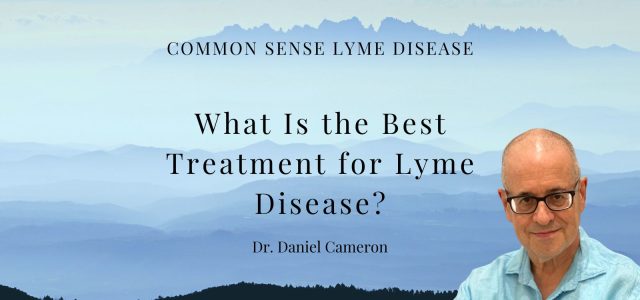
When patients come to the office with Lyme disease, many have already been treated — yet they’re still sick. Others are newly diagnosed, overwhelmed by strange symptoms and uncertain about what lies ahead.
The question most often asked is:
“What’s the best treatment?”
There’s No One-Size-Fits-All Answer
Lyme disease can affect the brain, nerves, joints, heart, and immune system — and no two patients present exactly alike. That’s why treatment is typically tailored to the full clinical picture, not just a checklist.
Clinical Decision-Making in Lyme Disease
Effective treatment depends on:
-
- How long symptoms have been present
- Whether symptoms were caught early or delayed for months
- Whether there have been relapses after prior treatment
- Whether co-infections like Babesia or Bartonella are involved
For some patients, the standard course of antibiotics is enough. Others require:
-
- Extended treatment durations
- Use of multiple antibiotics, especially in neurologic Lyme
- Targeted treatment for co-infections
- Supportive care: probiotics, anti-inflammatories, and avoidance of alcohol and processed sugar
Common Antibiotics Used for Lyme Disease
The choice of antibiotics for Lyme disease depends on disease stage, affected systems, and individual response.
Common oral antibiotics include:
- Tetracyclines
– Doxycycline
– Minocycline (Minocin)
– Tetracycline - Beta-lactams
– Amoxicillin
– Penicillin VK
– Cefuroxime (Ceftin)
– Cefdinir (Omnicef) - Macrolides
– Azithromycin (Zithromax)
– Clarithromycin (Biaxin)
– Sometimes combined with hydroxychloroquine to enhance intracellular activity
Intravenous antibiotics for neurologic or severe Lyme disease may include:
-
- Ceftriaxone (Rocephin)
- Cefotaxime (Claforan)
Treating Co-Infections: Babesia and Bartonella
Babesia
Babesia is a protozoan parasite not effectively treated with doxycycline. Treatment typically includes:
-
- Atovaquone (Mepron or Malarone)
- Combined with:
– Azithromycin (Zithromax)
Alternative agents for severe or relapsing cases may include artemisinin-based compounds or quinine-containing regimens.
Emerging therapies such as tafenoquine (Arakoda) — an antimalarial agent — have shown in vitro and animal model activity against Babesia microti. It has been used off-label in select patients with refractory or immunocompromised Babesia, particularly after failure of standard therapy. Tafenoquine requires screening for G6PD deficiency due to the risk of hemolytic anemia and remains under investigation in clinical practice.
Bartonella
Bartonella is classically associated with cat scratch disease but is increasingly considered a co-infection in Lyme disease. Common antibiotic choices include:
- Tetracyclines: doxycycline, minocycline, tetracycline
- Macrolides: azithromycin, clarithromycin
- Rifampin
- Bactrim (as part of a combination)
Note: Physicians remain divided on the role of Bartonella in tick-borne illness. Some consider it significant in persistent cases, while others remain skeptical. Its role continues to be investigated.
Persister-Directed Strategies
Laboratory studies have shown that Borrelia burgdorferi can adopt a dormant or slow-growing “persister” form that may be more tolerant to conventional antibiotics. This discovery has led to the exploration of non-traditional and repurposed therapies designed to target these persister forms. Some of these approaches are informed by lab-based success and are used in combination with antibiotics in clinical practice. Their role in persistent Lyme symptoms remains an active area of investigation.
Approaches Targeting Biofilms
Borrelia has also been shown in lab studies to form biofilms — protective bacterial structures that may shield the organism from both immune attack and antibiotic exposure. This has led to the use of biofilm-disrupting agents as adjunctive therapies in some treatment protocols. While evidence in humans is still limited, these approaches are intended to enhance the effectiveness of antibiotic regimens by breaking down microbial barriers.
These strategies are considered experimental or integrative and are typically used in conjunction with established antimicrobial treatment, not as replacements. More clinical research is needed to understand their full impact and safety profile.
Treating the Whole Person
Lyme disease is more than just an infection. It can impact nearly every system in the body. Effective treatment often requires addressing:
- Neuropsychiatric symptoms (anxiety, depression, OCD, panic, insomnia)
- Autonomic dysfunction (dizziness, rapid heartbeat, sweats, gut motility issues)
- Cognitive impairment (brain fog, memory issues, trouble concentrating)
- Fatigue and post-exertional malaise
- Muscle and joint pain
- Head pressure and migraines
- Light and sound sensitivity
- Vision changes or eye pain
- Tingling, numbness, or burning sensations
- Air hunger or shortness of breath
- Hormonal irregularities or menstrual changes
- Sleep disturbances
- Emotional volatility or mood swings
- Functional disability — trouble working, studying, or socializing
Successful care often depends on tracking these symptoms closely, adjusting treatment accordingly, and supporting both physical and mental recovery.
What Do the Guidelines Say?
Some physicians follow a more standardized approach based on IDSA (Infectious Diseases Society of America) guidelines, which recommend:
-
- 10–21 days of doxycycline for early Lyme
- Up to 28 days of IV ceftriaxone for neurologic or cardiac Lyme
- No retreatment if symptoms persist after standard therapy
Persistent symptoms under this model are typically attributed to post-infectious immune changes, not active infection. Further antibiotics are generally not advised.
This approach may work well for individuals diagnosed and treated early. However, in patients with delayed diagnosis, complex symptoms, or suspected co-infections, more flexible strategies may be needed.
Final Thoughts
The best treatment is the one that fits the patient.
Symptoms. History. Response to therapy.
Some individuals recover quickly. Others require extended care. Some cases challenge long-held assumptions about Lyme disease.
When symptoms persist, listening to the patient, reassessing the diagnosis, and remaining open to evolving evidence can make all the difference.
If recovery hasn’t come yet — don’t give up.
There are still options. And there is still hope.



I was in a coma for 3.5 weeks with Rocky Mountain Tick Fever about 50 years ago. They never mentioned Lyme Disease so I assumed when I survived DOA upon arrival I survived. After a dizzifying life journey and trying to find an answer for this latest onslaught of ALL LYME symptoms I realize i have chronic Lyme following a 7 month to date battle with bacterial infections which ultimately after trial and error antibiotics has improved 85% however i have existing biofilm (if that is skin that rolls off between fingers or shows up in toilet if you pull it while sitting there but is otherwise invisible. I have all the terrible Lyme symptoms and my doctor retired so I would truly appreciate any suggestions or referral to an LLMD in Salt Lake City utah.
Marilyn Clark
435.513.2375
It can be difficult to determine the cause or causes of any illness. I am not familiar who is in you area. You may find LymeDisease.org, ILADS or GlobalLymeAlliance helpful if you primary doctor can’t find some one for an evaluation.
Do you use herbal remedies to help lymes patients? If so what have you found to be effective.
I rely on in integrative medicine professionals.
I was bitten by a tick a week ago and have the bullseye rash. What should I be doing immediately to make sure I don’t end up with long Lyme? I’m also under active Breast Cancer treatment with UCSF
The CDC advised treatment for Lyme presenting as an EM rash even if the tests are pending or negative. I agree.
Hello Dr Cameron. Do you see international pacients online? I am from Europe. Thank you!
When is there a next appointment available
You should call my office with your questions.
For you see patients virtually?
You should call my office with your question.
Hi I’m French and diagnose chronic lyme since few month.
My doctor tried doxicycline during 2 months (2x100mg) then rocephine IM 1g/day during 25 days.
I feel better but not good so we decide to take doxicycline again and all the bad symtoms are coming back again (fasciculations in all my body)
Do you have advice for me ?
I need help
Thank you
arnaud
I have found that other antibiotics have helped https://danielcameronmd.com/best-treatment-for-lyme-disease/
How do you diagnose reinfection of Lyme in patents who had a previous fully treated infection?
My functional doctor did Medical Diagnostic Laboratories test and it shown some elevated Igg / Igm levels, but not enough to match CDC Lyme criteria. How do I know if I have Lyme or not?
It is not so clear cut. For example, labs tests can remain positive even after at tick borne infection has resolved.